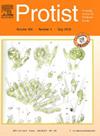化感作用调节了裸子草毒素谱和caspase-3/7的高激活
IF 2.1
3区 生物学
Q4 MICROBIOLOGY
引用次数: 0
摘要
化感作用可以通过抑制浮游植物的生长、破坏细胞器、细胞应激、代谢改变和诱导程序性细胞死亡等方式改变群落结构。本研究研究了麻痹毒素有害藻华(HAB)形成种G. catenatum对刺生植物C. marina vara . marina和鞭毛植物裸子藻的化感作用。在有和没有直接细胞接触的情况下,对裸子菊进行72 h的混合培养。记录生长、细胞形态、毒素谱和caspase 3/7活性。直接接触和不直接接触均显著降低了悬连藤的生长,毒素含量降低,caspase 3/7活性升高。毒素谱的变化也被观察到,总的来说,性腺毒素-2,3 (gtx2,3),脱碳酰性腺毒素-2,3 (dcgtx2,3)和B1类似物的含量较高。在所有情况下,直接与细胞接触的反应最高。这些结果提供了对共同发生的有害藻华物种的化感反应的新见解,证实了生长限制和毒素含量的代谢变化,以及诱导PCD。本文章由计算机程序翻译,如有差异,请以英文原文为准。
Allelopathy modulates toxins profiles and high activation of caspase-3/7 in Gymnodinium catenatum
Allelopathy in phytoplankton species can modify the community structure by growth inhibition, organelle damage, cellular stress, metabolic modifications, and by inducing programmed cell death (PCD). In this study, the allelopathic responses of G. catenatum, a paralytic toxin harmful algal bloom (HAB) forming species, towards the raphidophyte C. marina var. marina and the dinoflagellate Gymnodinium impudicum were evaluated. Gymnodinium catenatum was cultivated during 72 h in mixed cultures with and without direct cell contact with C. marina and G. impudicum. Growth, cell morphology, toxin profile, and caspases 3/7 activity were registered. Growth of G. catenatum exposed to C. marina and G. impudicum with and without direct cell contact was significantly reduced, toxin content decreased, and caspases 3/7 activity increased. Changes in the toxin profile were also observed, in general, with a higher content of gonyautoxin-2,3 (GTX2, 3), decarbamoyl gonyautoxin-2,3 (dcGTX2,3) and B1 analogs. In all cases the highest response was observed in direct cell contact with C. marina. These results allow new insights of the allelopathic responses of G. catenatum towards co-occurring HAB species confirming growth limitation and evidencing metabolic changes in the toxin content, as well as the induction of PCD.
求助全文
通过发布文献求助,成功后即可免费获取论文全文。
去求助
来源期刊

Protist
生物-微生物学
CiteScore
3.60
自引率
4.00%
发文量
43
审稿时长
18.7 weeks
期刊介绍:
Protist is the international forum for reporting substantial and novel findings in any area of research on protists. The criteria for acceptance of manuscripts are scientific excellence, significance, and interest for a broad readership. Suitable subject areas include: molecular, cell and developmental biology, biochemistry, systematics and phylogeny, and ecology of protists. Both autotrophic and heterotrophic protists as well as parasites are covered. The journal publishes original papers, short historical perspectives and includes a news and views section.
 求助内容:
求助内容: 应助结果提醒方式:
应助结果提醒方式:


